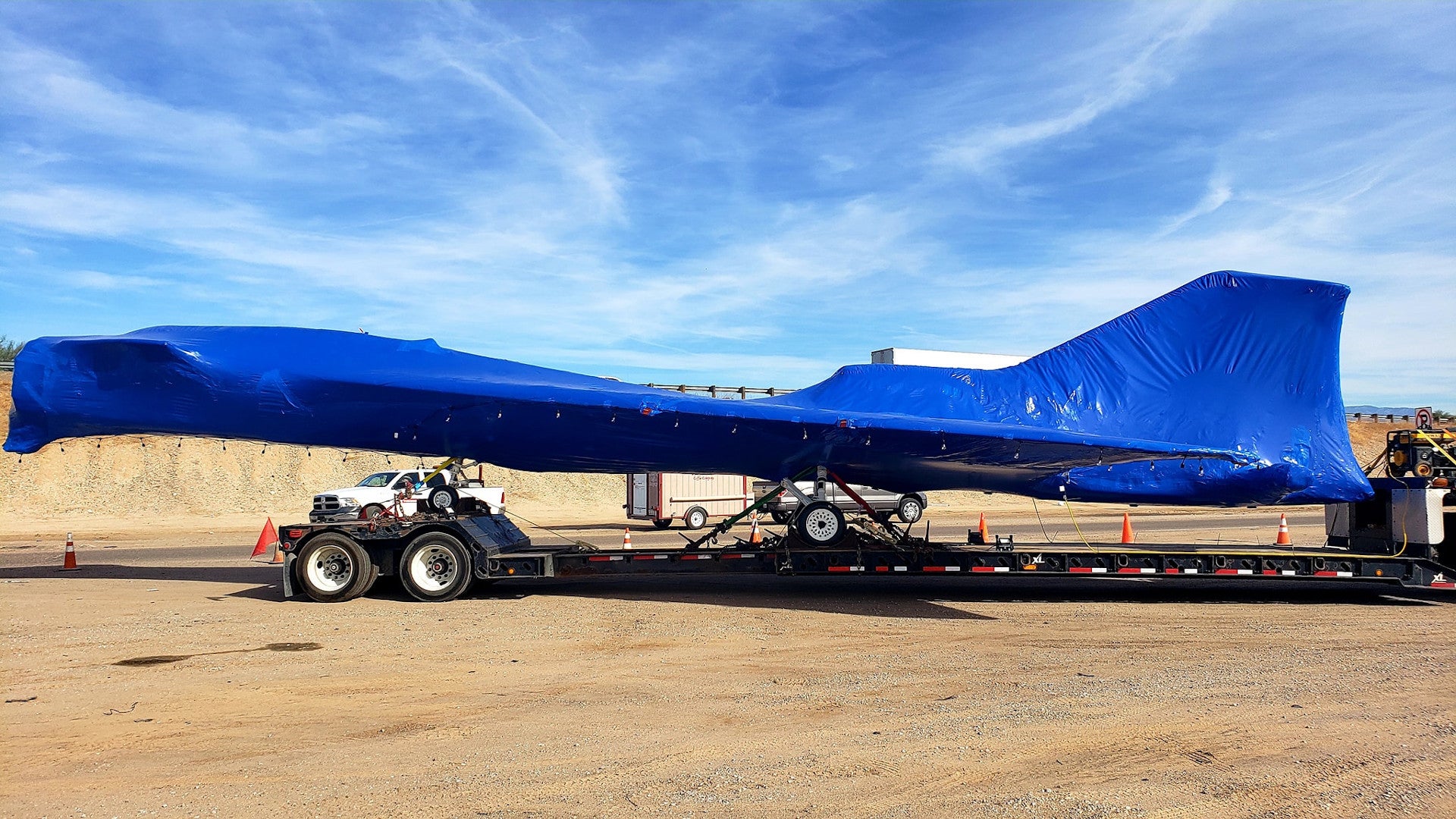The experimental X-59 Quiet Supersonic Technology aircraft, or QueSST, which Lockheed Martin’s Skunk Works is building for NASA, is now on its way to the company’s plant in Fort Worth, Texas. Once there, the jet, which is being designed to explore sonic-boom-mitigating technologies that could have significant impacts on the future of supersonic flight, will undergo structural testing ahead of a planned first flight next year.
Photographer Aldo Boccaccio grabbed pictures of the aircraft under wraps on a semi-trailer in Marana, Arizona earlier this week and was kind enough to share them with us. The plane has been under construction at Skunk Work’s facility at the U.S. Air Force’s Plant 42 in Palmdale, California, since 2018. Lockheed Martin confirmed to The War Zone that the current plan is to truck the X-59 to its Texas plant, which is best known for hosting the F-35 Joint Strike Fighter assembly line, for structural tests before bringing it back to Palmdale for the initial round of flight testing. It does seem somewhat curious that such a fragile, one-off design would be moved via road instead of something like a U.S. Air Force C-5 Galaxy transport plane.



The purpose of the X-59 and the QueSST program, as the name implies, is to explore technologies that could be able to dramatically reduce the sound and the felt impact of sonic booms on planes flying faster than the speed of sound. As The War Zone
has explained in the past, the disruptive noise and shaking that planes flying above the speed of sound produce remain key impediments to viable commercial supersonic aircraft. These issues also impose restrictions on military training involving supersonic aircraft and ‘quieting’ the booms could be beneficial during combat operations, as well.
The X-59, which is meant to be a purely experimental testbed, is an intriguing design that makes heavy use of components from other Lockheed Martin aircraft to help keep the design as simple and low-cost as possible. “Landing gear from an Air Force F-16 fighter, a cockpit canopy from a NASA T-38 trainer, a propulsion system part from a U-2 spy plane and a control stick from an F-117 stealth fighter are among the repurposed parts to be used on NASA’s newest airplane,” according to NASA. It is powered by a single modified General Electric F414 engine, other variants of which are found on Boeing’s F/A-18E/F Super Hornet fighters and EA-18G Growler electronic warfare jets, as well as the Saab Gripen fighter jet, among others.


Only around 10% of the design is entirely new, Skunk Works representatives told The War Zone and other reporters during a tour of its facilities at Palmdale earlier this year. At the same time, we were informed that this aircraft has been used to help prove out new advanced manufacturing techniques, including with regards to the large, single-piece composite skins on its wings. The X-59 was the first project at Skunk Works to actually make use of new, high-tolerance, and highly automated robotic drilling and tapping capabilities, which you can read more about here.


One of the design’s more unusual features is the complete lack of any forward visibility for the pilot. Instead, the individual flying the X-59 will use a remote vision system, called the eXternal Vision System (XVS), to “see” via the feeds from an array of forward-facing high-resolution cameras. This configuration allows for the entire front end of the aircraft to be optimized even more for sonic-boom-mitigating supersonic flight.

NASA’s official timeline says that the X-59’s first flight is expected sometime next year. Lockheed Martin could not immediately provide an update on exactly when the plane might take to the air for the first time. The initial flight testing, which will demonstrate things like the basic airworthiness of the aircraft, is expected to take nine months and run into 2023.
After that, NASA’s Armstrong Flight Research Center, which is situated within Edwards Air Force Base in California, will formally take delivery of the plane and then move on to its own initial test phase to hopefully demonstrate the design’s quiet supersonic capabilities. Skunk Works representatives told The War Zone and others who attended the tour at Plant 42 earlier this year that the goal is for the X-59 flying at supersonic speeds overhead to sound and feel like nothing more than someone “closing a car door” to people on the ground.

Public feedback will be solicited during the Community Response Study phase, which is set to take place between 2024 and 2026 and will involve flights over various U.S. cities. Push notifications will be used to alert people on the ground about X-59 flights and collect responses. In some cases, individuals will be told that the plane has gone zooming overhead when in reality that is not the case in order to try to identify the potential for “false positive” type responses and other outliers in the data.
All told, the X-59 program looks set to have a particularly exciting 2022.
Contact the author: joe@thedrive.com
